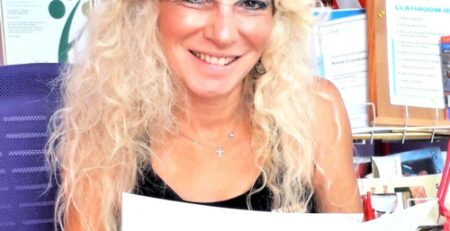” I’m wearing her shirt” and why this tells a lot about language teaching by Maria Davou

I’m sure you’ve seen tables like the one above in various books; it’s a very common way to present pronouns and possessive adjectives. The table implies some sort of alignement among persons, pronouns, adjectives etc. So, ‘I like my bike. It belongs to me.’ is the kind of exercise that follows so that the abovementioned alignment gets ‘consolidated’…
Well, here’s a true story from an actual class I observed: the learner was learning his pronouns through a similar table. He wrote the sentence ‘I’m wearing her shirt’ and the teacher corrected him. The teacher wrote instead, ‘I’m wearing my shirt’. The learner insisted that he was wearing her shirt. The teacher kindly insisted that he was wrong. So, in the world of this teacher, we can only wear our shirts, nobody can wear anyone else’s shirt!
This ‘obsessed-with-shirts’ world is a very boring one, right? It’s also a very unreal one. And for us, language educators, this world is deeply problematic. As is the table above.
Presenting language in such artificial, compartmentalized ways does not do any learner good, I think. It makes the teacher’s life easier of course- everyone’s wearing their own shirt! But is this how language actually happens in life? Do we learn Present Simple for 1,5 month, using it strictly and exclusively until we get it and then we can start using Past Simple? Do we learn all the colors first, then the numbers, then clothes and classroom objects? Doesn’t, in reality, all the above interact with the world we experience? Don’t we need words and structures to describe what surrounds us and what is inside our minds? Why do we break down language into artificial, unnaturally occuring lexical sets and grammar points? Why can’t I wear his shirt?
We live in a world of tables, formulas and rules about language that are mostly fake. We live in a language-learning worlds, where languages are dictated by coursebooks in very unnatural ways. We look for texts that present this language and exclude that language, because we need a system. We forget that language is a system already- a very well-regulated one in fact. Why can’t we just follow its beauty?
You might ask me, is there a way out? I’ve got one answer: the most natural, engaging, beautiful way to be exposed to the beauty of language is storytelling. Find stories, tell stories, share stories, ask your learners to make stories, bring stories, tell stories too. Teach through stories.
In any case, let’s allow people to wear each other’s shirt and let’s trust the infinite creativity of language, its playfulness and dynamic nature.
Exactly like language, “you’re never going to kill storytelling, because it’s built in the human plan. We come with it.” (Margaret Atwood, author of Handmaid’s Tale)










